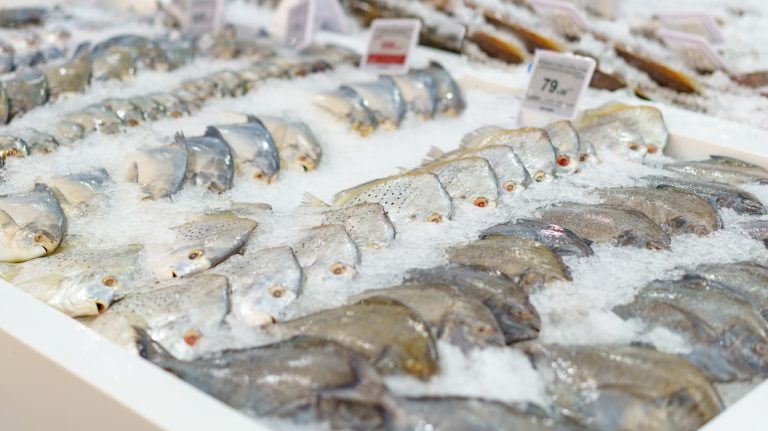Jacques Pépin’s goal has been to make it easier for people to cook good food in an easy manner. He’s influenced so many home cooks and professional chefs alike, and he’s continued cooking well into his later years (he turns 90 in December 2025). He’s worked as a restaurant chef and recipe developer, and his T.V. shows that he hosted solo and with Julia Child are classics that many have watched since childhood.
With such a long career in cooking, it’s not a surprise that Pépin has many favorite foods and recipes. And great news: Most of the foods and recipes are easy to find and make. Okay, that superb vintage year of Champagne that he likes might be a little expensive. But, he also likes foods as simple as eggs and English muffins, and recipes that take only a few minutes to prepare. Here are some of Jacques Pépin’s all-time favorite foods.
His mother’s stuffed eggs, or Les Oeufs Jeannette
In an interview with WBUR, Jacques Pépin called eggs “one of the greatest foods that you can have,” noting that if he were on an island, all he’d need would be chicken, eggs, and wine. He’s noted before that if he doesn’t know what to make for a meal, eggs are always an option. One of his favorite egg recipes, and one of his favorite foods overall, is a dish his mother made when he was a child, called “Les Oeufs Jeannette.” These are halved, hard-cooked eggs where the yolk has been mixed with herbs and stuffed back into the white. The egg halves are then pan-fried so that the yolk mixture develops a crispy crust, and the whole thing is then coated with a dressing. Think deviled eggs but taken two delicious steps further.
Pépin still makes this dish and has noted he hasn’t come across recipes similar to what his mother made. If you want to know how Pépin manages to peel eggs without ripping the white to shreds, he places the eggs in water that’s already boiling. When the eggs are done cooking, he cracks the eggs, before dunking them in cold water, by shaking the pan. He later peels them under running water when they’ve cooled.
A fines herbes omelette and potatoes
Fines herbes is a classic French herb mixture. While you may see some variation, a typical version contains fresh parsley, chervil, tarragon, and chives. It may also include herbs like thyme, but one thing all the versions of fines herbes have in common is that they all use very mild, delicate herbs that impart subtle flavors. You’re not going to find strongly flavored herbs in this combination. Fines herbes can be used in cooking or in uncooked dishes like salads.
Jacques Pépin has called an omelette made with fines herbes and served with potatoes the perfect dish to have for dinner, and it wasn’t unusual to find him using herbs that he grew in his own garden. If you want to use fines herbes, add them toward the end of the cooking process, because longer cooking will only lessen the flavor of the herbs, rather than emphasizing it. The ability of eggs to support and showcase other flavors make them one of the simplest and best foods to use when you first start experimenting with fines herbes, or any herbs for that matter.
Land O Lakes and Kerrygold butters
It’s always such a relief when an excellent chef’s recommendations for ingredients are easy to find, especially for butter. While gourmet butters taste wonderful, the fact that they can be harder for people to find if they don’t live near a specialty market is really frustrating. You know you’re missing out on something if you try to make a recipe without the specific butter it calls for. Thankfully, Jacques Pépin’s recommendations for butter for both cooking and for when you want European butter are at just about every supermarket.
For baking, good old Land O Lakes is what you need. What’s really interesting is that Pépin started using this brand because it was what he could find, instead of it being a specific brand he wanted from the start. He continues to use it to this day. As for European butter, Kerrygold is the go-to choice. American butters have at least 80% butterfat while European butters have at least 82%; that may not seem like a huge difference, but it really does show up in the taste and texture. Not only does Kerrygold have the slightly higher butterfat content that European butters are known for, but the company uses milk from Irish grass-fed cows that eat grass with a higher beta carotene content. This is supposed to contribute to the color of the butter.
Corn flakes
Sometimes, in the rush to remember your favorite foods, you actually overlook one or two. This is normal, and it happened to Jacques Pépin in an interview with Gourmet; he mentioned that an English muffin with some jam would be all he’d have for breakfast, and his wife had to remind him about corn flakes. Pépin did say he loves the cereal, enough to sometimes have them for lunch. However, he did admit to not having them for a while, which would explain them not being as memorable.
Corn flakes were invented in 1898 when John Harvey Kellogg, his wife, and his brother were trying to come up with healthy cereals for patients at a sanitarium that the family ran. The Kelloggs were Seventh-Day Adventists and followers of a rather bland diet (not even condiments were allowed), but the patients couldn’t deal with just how bland the diet was. The family tried to create a granola cereal that was acceptable but failed, instead producing wheat flakes. They then used the same process on corn and created corn flakes.
Cheese
Next up on the list is cheese, and it’s rather obvious that Jacques Pépin loves the stuff. He’s mentioned in interviews that he usually has cheese most days, and he included cheese in his list of foods he’d have at his last supper, which he said would contain what he loved to eat (Beaufort and white farm cheese would be among those dishes). And he does use cheese as part of many dishes; he’s mentioned adding feta to ground lamb patties and adding grated Swiss cheese as a garnish over soup, for example. He’s not a big dessert fan, apparently, instead preferring fruit and maybe a little cheese.
That last one isn’t so surprising as cheese is a common after-meal food. It’s not necessarily the actual dessert, as a sweet dish can follow the cheese course. But it’s not something you’d nibble on as part of the main meal. The after-meal timing is supposed to let diners savor the cheese without the flavor from other foods interfering.
English muffins
Let’s go back for a moment to look at what Jacques Pépin said about English muffins. It turns out that he loves having them for breakfast, with or without jam, and he just loves them in general, especially if they’ve been toasted well. He’s also toasted them for use as the buns for open-faced burgers and the bread for a toasted sandwich that his wife loved to eat.
English muffins were invented in the U.S. by an English baker named Samuel Bath Thomas. He somehow managed to create a griddle-cooking process that made the exterior of the muffin nice and crisp while leaving the center soft and full of the bubbly holes that soak up butter so well. That griddle was the key to the texture, and just how Thomas managed to cook the muffins was kept secret. While you can make English muffins at home, you won’t be able to get the exact airy center that you see in commercially baked English muffins.
Wild mushrooms
One of Jacques Pépin’s longtime hobbies was picking wild mushrooms, and considering how many pounds he’s picked up over the years – 500 pounds per year by his estimate, per KQED — that likely qualifies mushrooms as one of his favorite foods. Pépin even knows how to identify edible mushrooms and cook them correctly.
Why go to the trouble of picking wild mushrooms in forests rather than just buying them at a store? Wild mushrooms are obviously really fresh, and their texture can be better than the farmed mushrooms you find packaged for sale at typical supermarkets. Those mushrooms have also been wrapped up for a while, which can contribute to their softer texture. Both types are nutritious, although farmed mushrooms may have been exposed to UV light to increase the amount of vitamin D they contain.
Bread with butter
The very first food that Jacques Pépin mentions when describing his last supper for Melanie Dunea’s book, “My Last Supper,” is a golden, crunchy baguette with butter from Brittany. He said he could think of no better food than that. And when Tasting Table wrote about his love for the combination, he agreed, posting on Facebook that it was true. He has qualified in interviews that you need both excellent bread and excellent butter, but that’s a given. Terrible bread and terrible butter don’t cancel each other out to somehow make a good meal.
Note that his last supper called for butter from Brittany, rather than the Land O’Lakes or Kerrygold that he prefers to use in baking and for regular eating. Breton butter not only has that extra butterfat that makes European butters stand out, but it’s also salted (the best type for eating on bread) and uses high-quality milk. As with Kerrygold, the type of grass that Breton dairy herds eat contributes to the amazing flavor.
Bélon oysters
The second food that Jacques Pépin mentions for his last supper is Bélon oysters. True Bélon oysters (Ostrea edulis) are from the Bélon River in France, and for a long time, they were considered hard to find. Now you can get Bélon oysters that were harvested in the state of Maine, which has made the oysters much easier to get. Of course, there’s some back-and-forth over whether Maine Bélon oysters are true Bélon oysters, too, and the Maine oysters are often called European flat oysters, instead.
Back in the 1950s, scientists wanted to try to grow Bélon oysters in the U.S. The attempt didn’t work at first, and the scientists gave up. But 10 years later, the oysters suddenly started growing in the wild along Maine’s coast. When a diver found a much larger population in the 1980s, harvesting of those Bélon oysters in Maine began. Bélon oysters are known for their firm meat that has less of a briny taste than other oysters.
Beluga caviar
It’s probably not a surprise that Jacques Pépin would include Beluga caviar as one of his last supper foods; he said he’d devour tons of the stuff. Beluga is an extremely rare type of caviar owing to the fact that the Beluga sturgeon — caviar is made of fish eggs — may wait 20 years before it begins to spawn. Beluga caviar is soft and distinctly non-fishy with a flavor that’s often described as creamy.
Beluga caviar was banned in the U.S. for many years. However, the ban was lifted in 2021, although it’s still extremely expensive, with ½ ounce starting at over $100 and costing upwards of $10,000 for a pound. The Beluga sturgeon was once cheap but was then overfished, and it’s now endangered. The sale of its caviar was also banned worldwide by the U.N. in the 1970s, but that ban was lifted after one year. Producers still had to show that their methods of harvesting caviar followed sustainability standards.
Ham and eggs
Jacques Pépin loves eggs, and he loves Ibérico and boiled hams — both would be on the menu at his last supper of favorite foods. The eggs would be made in different ways, scrambled or sunny-side up, and he specifically said they’d be eaten alongside both types of ham rather than on their own.
Boiled ham may be easy to come by, but Ibérico ham, or jamón Ibérico, is an entirely different matter. The pigs that jamón Ibérico comes from aren’t rare; these are black Ibérico pigs, and you can find them in the western and southern portions of the Iberian peninsula. But to get the distinctive fatty and sweet nature of the meat, the pigs have to eat a lot of acorns. Free-range pigs that foraged on many, many acorns produce what’s usually rated as the best of the best jamón Ibérico, known as jamón Ibérico de bellota.
Gianduja
Jacques Pépin might not be the biggest dessert fan, but he’d have some sweets with his last supper (we do take that to mean these are among his favorite foods). Specifically, he’d have giandujas, which you’ll often see spelled as gianduja. This is chocolate that’s been mixed with hazelnut paste. If that sounds a bit like Nutella and other hazelnut chocolate spreads, that’s because those spreads are based on gianduja. However, they’re not exactly gianduja itself, which, while it contains cocoa, does not contain cocoa butter like the original version of Nutella did.
Gianduja was a wartime product that sprang from the minds of creative chocolatiers facing cocoa rationing after the Napoleonic wars in the 1960s in Italy. In order to continue making chocolate, they turned to hazelnuts from the Piemonte or Piedmont region. One chocolatier created a 70% to 30% cocoa-hazelnut paste mixture that took off among other chocolatiers. This mix was named gianduja after a theater character of the same name because that character was supposed to be from that region.
Stone fruit off the tree
Jacques Pépin loves certain stone fruits, as they’d also be a part of that last meal, but he specifies that they need to be fresh off the tree. And there’s good reason for that; fruit that’s been freshly picked from the tree often has a much more intense flavor than fruit that you get from the grocery store. Store-bought fruit has likely been sitting in a warehouse or on a ship for a while. In fact, you may be getting something that was picked before it had a chance to ripen properly. Ripe fruit may not survive the trip to a distant market, so producers pick it and pack it when it’s unripe. Distributors will expose the unripe fruit to ethylene gas (the same stuff apples give off that makes other fruit stored nearby become overripe) once the fruit is at the location where it will be distributed to other markets. Of course, the growing conditions also influence how intense the flavor of stone fruit can be.
As for which stone fruits, Pépin would have cherries, white peaches, which are sweeter and mellower than yellow peaches, and apricots. Pépin would also have wine peaches, which is a dish where peaches are literally soaked in wine.
Bollinger Brut 1996 Champagne
Jacques Pépin has some favorite drinks, as well, one of which is the classic Bollinger Brut 1996 Champagne. The year 1996 was known as a very, very good year for Champagne in general. As with other fruit, wine and Champagne grapes develop flavor and other characteristics based on their growing conditions. That year somehow turned out to be one of the best grape-growing years ever, with terrific climate conditions that produced delicious grapes. Of course, that means any 1996 Champagne is going to be tremendously expensive because it has few competitors in terms of taste; some bottles can fetch upwards of $1,000.
The Bollinger brand of Champagne is highly regarded, and the company produces Champagne only in years when the grapes are just about perfect. So, not only is a 1996 vintage a treat for Champagne lovers, but a bottle of Bollinger Champagne is also a major delight. Combine the two, and you have an amazing drink for an amazing feast of favorites.
Old bourbon
One other favorite drink of Jacques Pépin is old bourbon. In that list of last-meal foods, he mentions that he’d sip a few glasses of it very slowly because he’d want it to last. Bourbon is a form of whiskey made in the U.S.; Kentucky is known for its bourbon industry. The mash bill, or the mix of grains, has to be at least 51% corn, but the rest of the mash can contain grains like rye and barley.
Bourbon is then placed in oak barrels where the inner surface has been charred. That allows the oak to impart flavor into the bourbon in a process called aging. Bourbon has to be aged for at least two years by U.S. law, and the process is central to the development of the drink’s taste and color. The initial liquid in bourbon is clear, and the aging process gives it that glowing amber color.
Static Media owns and operates Tasting Table and Chowhound.





